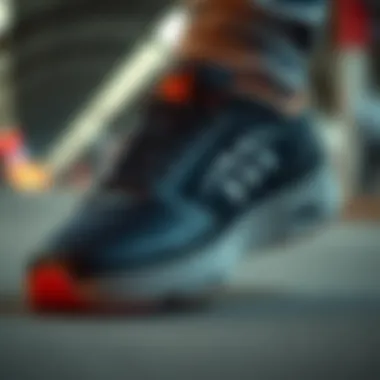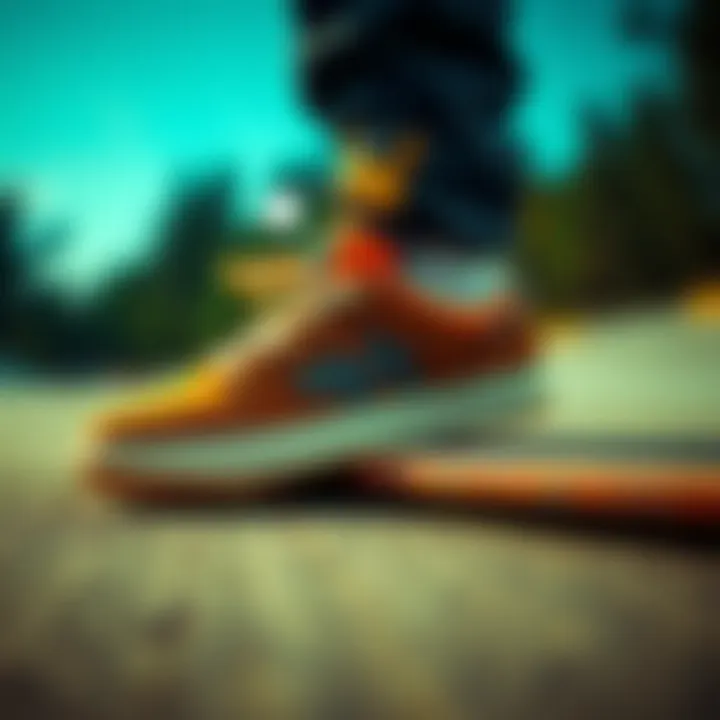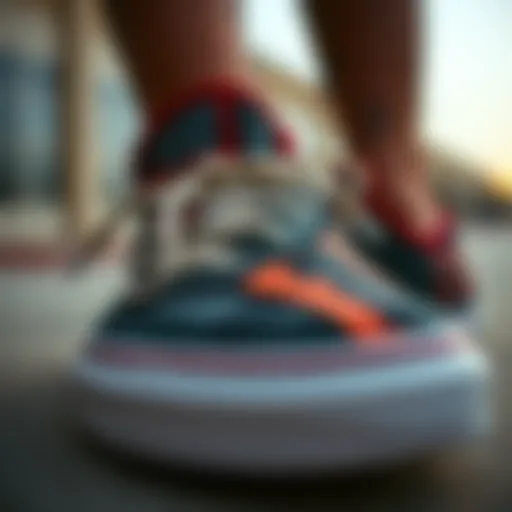Elements of Success for a New Skate Shoe Brand


Intro
The world of skateboarding is alive with a unique spirit, a culture that thrives on creativity, style, and community. When starting a new skate shoe company in this vibrant arena, one must grasp the essence of what skaters truly value. More than just a product, skate shoes represent a lifestyle, a mode of expression for countless individuals who find freedom on four wheels.
In crafting a skate shoe brand, understanding the nuances within the skateboarding community can be the deciding factor between success and anonymity. Enthusiasts are not merely consumers; they are part of a tribe that seeks authenticity. This article will illuminate essential elements contributing to a new company's journey, from innovative design to effective marketing strategies, all while fostering an engaged community around the brand.
Let's take a closer look at what it takes to stand out in this competitive landscape.
Innovative Design
In the realm of skate shoes, design is not just about aesthetics—it's the foundation of performance. Designers must consider functionality alongside style. For instance, a shoe with a proper grip and board feel can dramatically improve a skater's performance. Specific materials can enhance flexibility and cushioning, crucial for executing tricks without sacrificing comfort.
Key Elements of Design:
- Upper Materials: Choose materials like suede or leather for durability.
- Sole Construction: Opt for rubber soles that provide excellent grip and durability.
- Lacing Systems: Consider designs that keep shoes snug without restricting movement.
Skate shoes should embody the spirit of skateboarding. This means they need to be visually appealing but also functional, pushing the boundaries while honoring tradition.
Targeted Marketing Strategies
A skate shoe brand must tell its story in a way that resonates with its audience. Creating a brand image that reflects the passion and culture of skating is essential. Engage with the community through social media platforms, skate parks, and events. Authenticity is key; promote the brand through skater endorsements rather than traditional advertising. This builds trust and turns users into advocates.
Strategies to Consider:
- Leverage Social Media: Use Instagram and TikTok to showcase user-generated content and vibrant visuals of skating.
- Collaborative Events: Host local competitions or sponsor skateboarding events to create buzz within the community.
- Influencer Partnerships: Align with reputable skaters to bridge the gap between the brand and the audience.
Understanding Consumer Preferences
Knowing what consumers seek in skate shoes is an ongoing process. Regular surveys and engaging with skaters can provide invaluable insights into their preferences. Are they looking for durability, comfort, or a specific style? Keep an ear to the ground; trends can shift with the winds of change in the skateboarding world.
"Listen to the community; they will tell you what they want. Sometimes it’s not about what you imagine, but what they feel."
Crafting Brand Identity
Establishing a strong identity is crucial for differentiation. The logo, color palette, and overall branding must resonate with the skaters' ethos. A well-defined brand narrative can unify a company’s efforts in design, marketing, and community engagement. Think of brands like Vans or Nike SB—they have become synonymous with skate culture due to their distinctive branding that aligns closely with skater values.
Materials and Sustainability
Modern consumers are increasingly eco-conscious, and words like "sustainability" are gaining traction. Exploring materials that are renewable or recycled can significantly boost a brand's image. For example, utilizing vegan leather or composites made from recyclable materials can attract a specific segment of the market. Not only do customers appreciate sustainable practices, but it also sets a company apart as a leader in innovation.
Role of Technology in Development
The advancement of technology introduces new possibilities in skate shoe design. Companies can explore 3D printing and smart materials that adapt to the wearer’s foot shape or performance needs. By investing in research and development, new brands can position themselves at the forefront of the industry, paving the way for groundbreaking yet practical designs.
Community Engagement Strategies
Lastly, building a loyal customer base demands robust community engagement strategies. Create forums or social media groups that allow fans to discuss, share experiences, and connect with the brand. Offering exclusive content, like behind-the-scenes looks at shoe production or interviews with pro-skaters, can foster deeper connections.
Bringing the skate community together will not only solidify brand loyalty but create a sense of belonging around your product.
The journey of a new skate shoe company is riddled with challenges, yet the reward of creating something authentic and needed in the skating world is immeasurable. The road may be long, but with a solid foundation rooted in understanding and connection, success can certainly be within reach.
Prelude to the Skate Market
Exploring the skate market is like stepping onto a board for the first time—it's essential to understand both the terrain and your footing. The skateboarding landscape is not just a niche; it reflects a subculture deeply rooted in creativity, individualism, and community. This section dives into why grasping the dynamics of this market is crucial for anyone looking to carve out their space with a new skate shoe brand.
Understanding the skate market illuminates the nuances that define consumer preferences. Not only does it frame the way we perceive skating culture, but it also highlights the trends shifting underfoot. As skaters become more discerning, they seek shoes that reflect their lifestyles, influence their performance, and affirm their identity. This is where the interplay of market insight and innovative design becomes vital for a new skate shoe company.
The skateboarding community values authenticity, so brand messaging and product offerings must resonate with their experiences. As we break down the specifics of the skateboarding industry, we'll uncover opportunities to fill voids in the market and respond to emerging trends, crafting shoes tailored for various skate styles, from street to vert.
Overview of the Skateboarding Industry
The skateboarding industry has matured into a multi-billion dollar sector over the past decades. Initially, it appeared as a carefree pastime, but now it encompasses genres that range from competitions to street performances. In particular, the advent of professional skateboarding has transformed many skaters into ambassadors for the sport, paving the way for brands willing to invest in this avenue. This professionalization is evidenced in major international events like the X Games and the inclusion of skateboarding in the Olympic Games, which helped propel skate culture into mainstream recognition.
Interestingly, while sales figures for skateboards have stabilized or even dipped slightly in recent years, skate shoes continue to thrive. This dichotomy demonstrates the shoes' role as both fashion statements and functional necessities—appealing not just to skaters but also to casual consumers drawn in by the skate aesthetic. Many brands, from Vans to Nike SB, understood the importance of merging function with style, a lesson that new entrants must heed.
Trends Impacting Skate Shoe Sales
Without a solid grasp of current trends, a new brand could be akin to a skater without knowledge of their environment—taking risks that could have been easily avoided. One driving force in skate shoe sales is the consistent demand for limited-edition releases. This phenomenon fuels a sense of urgency and exclusivity, encouraging skaters to snap up shoes as collector’s items rather than mere functional gear.
Additionally, the rise of eco-conscious consumers has driven skate brands toward more sustainable practices. Utilizing recycled materials and adopting transparent supply chains have become essential considerations—not merely for brand differentiation but as filtered lenses through which modern skaters make purchasing decisions.


Moreover, the crossover into lifestyle fashion is another trend reshaping the industry. As skate sneakers gain traction in casual wear, they command progressive designs that can seamlessly transition from the skate park to social settings. Understanding these trends—rarity, sustainability, and the merging of play with everyday wear—can guide new brands in their approach to product development and marketing.
"The spirit of skateboarding is about freedom of expression and creativity, which should reflect in every product we bring to market." - A voice from the skate community.
Founding the Company
Establishing a skate shoe company is not a walk in the park. This journey is pivotal, as it lays the groundwork for everything that follows. Founding the company means not just creating shoes but breathing life into a brand that resonates wholeheartedly with skaters. It involves careful planning, a vision to innovate, and an understanding of the market that will set the tone for the brand’s identity and future growth.
Identifying the Gap in the Market
Before you even think about designing shoes, it's crucial to understand what's missing in the current landscape. The skateboarding community is diverse, with varying preferences based on style, performance, and environmental impact. A possible gap could be in the offerings for eco-conscious skaters who prioritize sustainability but don't want to sacrifice style or performance.
- Recent Surveys: Insights from platforms like Reddit show that many skaters feel their choices are limited when it comes to sustainable options. This highlights a niche market waiting to be tapped into.
- Community Feedback: Engaging with local skate parks to gather opinions can provide valuable insights. Asking skaters what they feel is lacking could illuminate untapped potential.
Building a product line that speaks to these needs allows for differentiation. For example, what if you crafted shoes that use recycled rubber materials but also sported fresh designs reflective of local culture? The blend of functionality and social responsibility could be a significant selling point for your brand. Identifying such gaps requires thorough research and immersion in the skater lifestyle; it’s not enough just to look at statistics.
Building the Brand Vision
Once you’ve figured out what the market needs, it’s time to establish a clear brand vision. This vision is your North Star, guiding every decision along the way. It articulates your values, your story, and the emotions you want to evoke in your customers.
- Value Proposition: Why do you exist? Maybe your brand stands for quality, community engagement, or sustainability. If you're the only brand promising eco-friendliness alongside performance, that sets you apart dramatically.
- Storytelling: Craft a narrative around your brand. Where did the inspiration come from? Was it a personal experience in the skate park or a moment of insight while interacting with the community? Relating real-life stories, discussing challenges faced, and showcasing triumphs can build camaraderie with potential customers.
- Visual Identity: Think logos, color schemes, and typography. These elements should reflect the core of your brand. They should resonate not just with skateboarders but with a wider audience who share your values.
By focusing on these aspects of founding the company, you set a strong foundation. The key takeaway is that it isn’t just about selling shoes; it’s about crafting a lifestyle and a community around your brand. For further reading on market research and branding strategies, you might find this useful: Harvard Business Review.
“In the world of skating, a company is more than just products. It's about the culture, the community, and how you choose to engage with it.”
Engaging with your audience and addressing their concerns is not merely a business tactic—it’s a way to build relationships that foster brand loyalty.
Design Elements
When one thinks about skate shoes, the importance of design cannot be brushed aside. The right design can mean the difference between a shoe that excels at performance and one that becomes mere eye candy in the skate shop. In this section, we’ll explore the various design aspects crucial to a successful skate shoe, breaking them down into functional features, aesthetic appeal, and material choices.
Functional Features of Skate Shoes
The backbone of any skate shoe is functionality. Skateboarding places unique demands on footwear. A good skate shoe must provide stability, grip, and support while allowing flexibility for those tricky tricks. For instance, features like the following are essential:
- Grip: A skateboarder's connection to their board starts with the soles of their shoes. The right rubber compound and tread pattern can make all the difference in performance.
- Cushioning: Impact absorption is paramount. A well-cushioned insole can soften landings, reducing the strain on a rider’s joints over time.
- Support: Reinforced areas, especially around the ankle, provide additional support, reducing the risk of injuries during high-impact activities.
Skaters often look for shoes that have a low profile: this enhances a rider's sensitivity and control on the board. Prioritizing these functional aspects is non-negotiable in crafting a skate shoe that skaters will trust.
Aesthetic Appeal and Branding
The aesthetic of a skate shoe is just as significant as its functionality. Skate culture thrives on personal expression, so having a shoe that reflects style is crucial. Colors, patterns, and branding all play their part. Here are some considerations:
- Bold Colors and Patterns: Eye-catching designs can set a brand apart in a sea of dull options. Bright colors or even a unique pattern can resonate with a specific demographic.
- Brand Identity: Whether it’s a sleek logo or a distinctive set of stitching, consistency in branding helps consumers identify and trust the product. Strong visual branding fosters a connection to the community, creating loyalty.
- Limited Editions: Often brands release limited-run designs which create a sense of exclusivity and urgency. These shoes not only become collectible items but also elevate the brand’s status within the skating community.
Material Selection and Durability
Lastly, material selection is a key aspect of the design that cannot be overlooked. The durability of skate shoes is critical. Poorly made shoes warp and break down quickly, leading to foot discomfort or worse, injury. Here are factors to consider:
- Upper Material: Leather or synthetic options each have their pros and cons. While leather offers durability, synthetics can be lighter and more breathable.
- Sole Composition: Using high-quality rubber compounds can prolong the lifespan of the shoes. A strong sole is essential, as it undergoes significant wear during grinding or sliding on rails.
- Breathability: Features like mesh panels can keep feet cooler and dryer, increasing comfort during long skate sessions.
As each of these areas ties back to both functionality and aesthetics, careful consideration and strategic choices will lead to a shoe that appeals to performance-based skaters while also attracting those who place a premium on style.
A well-designed skate shoe must strike a perfect balance between performance, aesthetics, and durability to truly resonate with the skating community.
For further insights into skate shoe materials and design, check out resources like Skateboarding and The Evolution of Skate Shoes.
Technological Innovations
In the rapidly evolving world of skateboarding, technological innovations are not just beneficial; they are essential. These innovations facilitate the development of skate shoes that are not only functional but also highly specialized to meet the demands of skaters. From materials to manufacturing processes, technology defines what could be the next breakthrough in skate shoe design, affecting everything from comfort to performance.
The need for innovation arises from a couple of factors: skater preferences and competitive pressure. Skaters, often known for their discerning taste, continuously seek gear that enhances their performance while maintaining style. Moreover, competition among skateboard brands is fierce; failing to integrate the latest technologies can result in a brand becoming irrelevant.
Incorporating Advanced Technologies
When discussing advanced technologies in skate shoe designs, there are several aspects to consider. One major element is the use of specialized foams and cushioning systems. Brands like Nike have invested heavily in this area, creating proprietary foam technologies that provide superior shock absorption and energy return. This thwarts discomfort and injuries, allowing skaters to perform their tricks with confidence.
Moreover, integrating smart materials into the manufacturing process plays a crucial role. Adaptive materials that change properties in response to pressure or temperature can enhance the shoe's performance. This is a game-changer for skaters, as it provides a personalized fit and feel. The blend of style and function is particularly appealing to new waves of skating enthusiasts.
To fully harness these technologies, brands must invest in research and development while nurturing collaboration with tech companies. This fusion can lead not just to advancements in performance, but also in sustainability, addressing both skater and environmental concerns.
The Role of 3D Printing in Customization


3D printing has revolutionized many industries, and skateboarding is no exception. This technology offers an ingenious method to customize shoes according to individual preferences. With 3D printing, a brand can develop personalized shoe components that suit the unique foot shape and performance style of each skater.
For instance, unique outsoles designed to cater to specific skateboarding techniques can vastly improve grip and control. Moreover, printing components reduces waste since things are made on-demand, rather than churning out products that may not sell.
It's not just about the design; the ability to rapidly prototype and test new ideas opens new doors for creativity. Brands can experiment with different styles without the hefty costs associated with traditional manufacturing methods.
In summary, the integration of 3D printing into skate shoe production not only enhances customization opportunities but also aligns with a more sustainable production model. By leveraging this technology, brands can forge a deeper connection with skaters, while simultaneously addressing the increasing demand for environmental responsibility.
"The future of skate shoes lies in a balanced equation of technology and community. Engaging skaters through personalized options will create a loyal following that drives brand success."
By investing in technological advancements like specialized materials and 3D printing, new skate shoe companies can carve out a niche in the competitive market, drawing in both hardcore skaters and casual enthusiasts alike.
Market Positioning Strategies
In a landscape where skate shoes are not just functional gear but an extension of identity, effective market positioning strategies are the backbone of a new brand’s success. How a company positions itself can dictate its appeal to potential skaters and, ultimately, its longevity in the industry. A thoughtful approach to this aspect can help differentiate the brand from competitors, carve out a unique space in the market, and foster deeper connections with consumers. It enables companies to highlight their unique values and strengths, which is crucial in a cluttered marketplace.
Target Demographics
Understanding the target demographic isn’t merely a box to check; it’s the keystone of any good marketing strategy. The skateboard community is diverse, straddling various age groups, lifestyles, and levels of expertise. From the newbies who are just picking up a board to seasoned pros shredding at a local skate park, identifying who the brand aims to attract can influence everything from design choices to marketing campaigns.
- Youth vs. Adult Skaters: Young skaters may prioritize style over durability, drawn to trends and aesthetics, while adults might look for longevity and support.
- Lifestyle and Culture: Some may lean toward streetwear influences, while others resonate with a more traditional skate culture, often reflected in their gear choices.
- Skill Level: New skaters often search for affordability and functionality, while experienced skaters might invest more in specialized features and premium materials.
Knowing the nuances of these groups can help the brand tailor its messaging and product offerings effectively, meeting consumers where they are.
Brand Messaging and Storytelling
In the skateboarding world, where authenticity reigns supreme, effective brand messaging is essential. The stories a brand tells shape how skaters perceive and connect with it. To capture the hearts and minds of their audience, companies should craft narratives that resonate with the community's values and experiences.
- Authenticity: It’s about staying true to the culture; consumers tend to rally around brands that showcase genuine passion for skateboarding. This can be communicated through:
- Values and Mission: Highlighting commitment to sustainability or community engagement can enhance brand loyalty.
- Community-Centric Campaigns: Participating in local events or focusing on regional skate scenes can bring the message home that the brand is in it for the long haul.
- Behind-the-scenes looks
- Skater endorsements that feel relatable
- Content that reflects real skate experiences
"Consumers today want brands that tell their stories, but even more importantly, they want brands that listen and respond to their own stories."
A brand's narrative should not merely be a marketing gimmick; it should genuinely reflect the synergy between what the brand stands for and what the skateboarding culture believes in. In doing so, they not only differentiate themselves from competitors but help cultivate a loyal customer base that feels a part of something larger than themselves.
Sustainability Practices
In today's world, where environmental concerns are front and center, sustainability practices have become pivotal for any new brand, particularly in industries like skateboarding. A skate shoe company must not only cater to skaters' needs but also embrace the duty to protect our planet. Sustainability is not just a trend; it’s a core value that can significantly enhance brand loyalty and resonate with a conscientious clientele. Integrating sustainable practices can set apart the brand in a crowded market, attracting skaters who prioritize eco-friendly choices.
Environmentally Friendly Materials
A key component of sustainability in skate shoe production lies in the selection of environmentally friendly materials. Unlike conventional materials which may use harmful chemicals and processes, sustainable alternatives like organic cotton and recycled rubber offer viable options. For instance, using recycled materials not only reduces waste but also minimizes the need for virgin resources. This approach can lead to lower production costs over time and appeal to eco-conscious consumers.
Some brands have started incorporating biodegradable materials into their lineup. Imagine a skate shoe that could decompose naturally once its life cycle ends! This transforms a simple skate shoe into a part of a larger ecosystem.
- Plant-Based Leather: Made from materials like pineapple leaf fibers or cactus, these alternatives reduce reliance on animal products and the environmental toll of livestock farming.
- Natural Dyes: Using plant-based dyes cuts down on chemical runoff, ensuring cleaner waterways and healthier communities.
Skaters appreciate the story behind their gear. When the materials are ethically sourced, it adds a layer of authenticity that many buyers are drawn to.
Reducing Carbon Footprint
Beyond materials, reducing a brand’s carbon footprint forms another crucial aspect of sustainability. The carbon footprint represents the total greenhouse gas emissions caused directly and indirectly by making the product. For a skate shoe company, minimizing this impact can include various strategies.
- Local Production: Manufacturing as close to the customer base ensures less energy spent on transport. This not only cuts down on emissions but also enhances community relations by creating local jobs.
- Energy-Efficient Manufacturing Processes: Investing in renewable energy sources like solar panels for factories can significantly lower emissions during production.
- Sustainable Packaging: Utilizing recycled or reusable packaging is a simple way to cut down additional waste. Less plastic and more cardboard can make a huge difference.
"Embracing practices that lower carbon emissions can turn your brand from a mere product to a leader in change. Customers appreciate knowing their purchase helps protect the future."
Skate culture thrives on community spirit, and reinforcing a commitment to sustainability can create a shared sense of purpose among consumers. This alignment not only enhances the brand’s image but can also lead to increased sales and customer loyalty. Understanding this, a fresh skate shoe brand has an opportunity to establish itself on a solid foundation of eco-friendly practices, ensuring both profitability and responsibility.
For more insights on the impact of sustainability in the fashion and footwear industry, check out Sustainable Fashion and Reddit discussions.
By embedding sustainable practices into every aspect, from production to outreach, companies are not just skating by—they're paving the way forward.
Community Engagement
In today's fast-paced world, the importance of community engagement for any brand, especially in niche markets like skateboarding, cannot be overstated. For a new skate shoe company, connecting with the local skating community serves as both a marketing strategy and a vital part of building brand identity. Community engagement goes beyond mere transactions; it's about creating relationships, gaining trust, and becoming a part of the culture. When skaters feel a personal connection to a brand, they are more likely to become loyal customers, influencing their peers along the way. Notably, engaging with the community can bolster a brand's reputation, solidifying its place in the competitive skate market.
Collaborating with Local Skate Parks
Collaborating with local skate parks is one of the most impactful ways to engage with the community. These parks are not merely venues for skating; they are social hubs where skaters gather, connect, and share their passion. Therefore, establishing partnerships with these parks can yield significant benefits.


- Authenticity: By working closely with skate parks, a brand can showcase its commitment to supporting the sport and its participants, which resonates deeply with skaters who value authenticity.
- Events and Showcases: Hosting events at skate parks, such as contests or demos, creates excitement and invites skaters to try the brand's shoes firsthand. This on-the-ground experience can lead to immediate buzz within the skate community.
- Feedback and Improvement: Collaborations can also serve as a source of valuable feedback. Directly interacting with skaters provides insights into their needs, preferences, and pain points, aspects of product development that can make a world of difference.
By fostering partnerships with local skate parks, brands can establish a robust presence within the community, generating genuine excitement about products and a deeper connection with skaters.
Sponsorship of Local Events
Sponsoring local skating events is another strategy that can enhance community presence and brand loyalty. These events may vary from competitions to elite showcases or even grassroots gatherings. Regardless of the type, sponsorship offers a platform for visibility and engagement.
- Brand Exposure: When a brand sponsors local events, it gains exposure to a wider audience. Skating events draw skaters and spectators from various demographics, offering an ideal opportunity to showcase products and brand identity.
- Networking and Partnerships: Sponsoring events fosters networking opportunities with local influencers and industry professionals. This can lead to further collaborations, enhancing the brand’s credibility and reach.
- Supporting the Culture: By funding local events, a brand shows its dedication to the skateboarding culture. Skaters appreciate companies that invest in their community, contributing to a pantheon of homespun loyalty to the brand.
In essence, community engagement through collaborations and sponsorship not only builds connections but also amplifies the brand's story. More than just a shoe company, the brand becomes a booster for local skating culture, facing the challenges of authenticity and consumer engagement with a united front.
Launch Strategy
In the journey of establishing a new skate shoe company, the launch strategy stands out as a pivotal element. This aspect involves not just the initial release of your product, but also the careful planning and execution of various marketing tactics that can significantly influence the brand's long-term success. It's about creating a buzz, engaging with the community, and ensuring that your brand gets noticed amid all the noise in the market. A thoughtful launch strategy encompasses pre-launch marketing activities to build anticipation and well-crafted events that effectively introduce your products to the world.
Pre-Launch Marketing Tactics
Before the shoes hit the shelves, laying the groundwork through pre-launch marketing can create lasting excitement. Here are some tactics to consider:
- Social Media Teasers: Platforms like Instagram and TikTok are essential for grabbing the attention of younger audiences. Utilize engaging visuals and snippets that hint at your upcoming designs without revealing everything right away.
- Influencer Partnerships: Team up with respected figures in the skateboarding community. Their endorsement can act like a powerful stamp of approval, making your brand more credible and appealing.
- Sneak Peeks: Consider sending out limited early editions or samples to select skaters and influencers for their feedback. This tactic not only fosters buzz but also creates the impression of an exclusive product.
- Create a Countdown: Build anticipation with a countdown on your website and social media. This can significantly strengthen engagement as fans look forward to the big reveal.
"Creating buzz before a launch is like skating at the edge of a ramp-- build up the speed to make the jump worthwhile."
A comprehensive approach ensures you’re hitting your target audience effectively and positioning your brand as a fresh player in the skate scene.
Launch Events and Promotions
The actual launch event is where all the planning comes to fruition, offering an opportunity to connect directly with consumers. Here are some strategies for making this phase impactful:
- Host a Skate Jam: Throwing a skateboarding event not only showcases your shoes but also involves the community directly. Consider partnering with local parks and offering competitions or giveaways to keep the energy high.
- Engaging Promotions: Create incentives for early buyers—special discounts, limited edition gear, or access to exclusive events can drive immediate sales and foster loyalty.
- Live Demos: Highlight the features of your shoes through live skate demos. This allows potential customers to see how the shoes perform under real conditions, elevating their interest.
- Leverage Social Media During the Event: Encourage attendees to share their experiences and use a specific hashtag related to your brand. This will not only provide real-time visibility but also generate content for your brand’s platforms.
Adopting a clever mix of these tactics lays a rich foundation for your brand’s identity and resonates with core skate culture while ensuring your products stand out in a competitive marketplace. By executing a well-thought-out launch strategy, you're not just selling shoes, you're establishing a community.
Challenges in Starting a New Brand
Starting a new skate shoe company is like trying to carve your name into a bowl made of ice—a bit tricky but not impossible. The skateboarding industry is not just a niche; it’s a lifestyle, and you’re stepping into a ring filled with contenders that have been around for years. Being aware of the hurdles involved in launching a brand is crucial for any budding entrepreneur. Key elements include understanding the competitive landscape, recognizing consumer preferences, and adapting to market dynamics. Consideration of these challenges can mean the difference between becoming part of the crowd or rising above it.
Navigating Industry Competition
The skate shoe market is saturated, filled to the brim with established brands that have built strong loyalties. When you throw your hat into the ring, you need a strategy that’s sharper than a freshly grinded skateboard. First, comprehension of who your competitors are is essential. Look at brands like Vans or Nike SB. Their marketing strategies and product offerings set a high bar. Study how they engage with their customers and their storytelling approach.
To effectively navigate through these waters, it’s prudent to carve out your niche. Ask yourself: what can you offer that’s different? Maybe it’s a design that’s never been seen before or an emphasis on environmentally friendly materials. Defining your unique selling proposition—your USP—is critical.
Additionally, keep your ear to the ground about trends. For instance, the rise of sustainable materials is catching fire. If you can offer a quality shoe made from recycled rubber or organic cotton, you might tap into an emerging consumer base that prioritizes eco-friendliness.
"The market is not just a battleground; it’s a conversation. Engage wisely!"
Understanding Consumer Behavior
Understanding your audience is likewise key to making sense of the chaos. It's like trying to skate without knowing the ramp’s angle—you might end up eating dirt. Different demographics gravitate toward different brands for various reasons. Some skaters are passionate about performance and durability; others are keen on style and trends.
Conducting thorough market research often uncovers insights that can make your brand stand out. Surveys, focus groups, and even social media polls can reveal what consumers like and dislike about existing products. Platforms like Reddit and Facebook can be excellent avenues for gauging consumer sentiment.
In addition, analyzing purchasing behavior is paramount. When do consumers buy skate shoes? Are they more likely to make a purchase after an event, like the X Games, when interest peaks? Or do they lean toward shopping during holiday seasons? Timing your launches and promotions based on consumer behavior can significantly impact sales.
In summary, while launching a new skate shoe brand presents a series of challenges, they are not insurmountable. With keen market awareness, a solid grasp of competition, and a deep understanding of consumer behavior, you can build a foundation strong enough to endure in a fast-paced environment.
Future Prospects
In the realm of skateboarding, where innovation meets tradition, a new skate shoe company finds itself at a critical juncture. The future prospects of such a venture can dictate not just its survival but its legacy within this vibrant community. As the market evolves, understanding future trends is not merely an option; it's a necessity for shaping a resilient brand that resonates with skaters and enthusiasts alike.
Expanding Product Lines
The demand for diversity in skate products has never been greater. Customers are always on the lookout for variety that caters to different styles, performances, and preferences. Expanding product lines could mean venturing beyond basic skate shoes to include specialized footwear aimed at niche markets, such as casual wear, eco-friendly options, or limited edition collaborations with skate legends.
- Limited Edition Releases: The allure of exclusivity can drive hype and engagement. Consider launching a series of shoes that pay homage to local skate spots or influential skaters.
- Diversifying Styles: From high tops to slip-ons, the options can appeal to varied tastes. Don't forget to explore vibrant colors and prints that resonate with the artistic side of skate culture.
- Seasonal Lines: Showcasing products tailored for different climates can attract customers throughout the year. Think lightweight, breathable designs for summers, contrasted with warmer variants for colder seasons.
Utilizing customer feedback effectively can guide this expansion. A brand that actively listens can adapt product offerings in line with what the community craves, aligning perfectly with the spirit of skateboarding itself.
Adapting to Market Changes
The skating industry is not static; it’s a dynamic landscape that shifts with market trends, technologies, and preferences. Adapting to market changes is crucial for capturing emerging opportunities while mitigating risks. Keeping a pulse on trends can help in reshaping strategies to stay relevant.
- Social Media Trends: Platforms like Instagram and TikTok can give insights into what styles are currently hot among skaters. Brands should monitor influencers and community-generated content to adapt accordingly.
- Sustainability Initiatives: Increasing consumer awareness of environmental issues is reshaping buying habits. A brand that incorporates sustainable practices not only attracts eco-conscious shoppers but also builds trust and loyalty.
- Technological Trends: The integration of technology in skateboarding gear—from smart shoe designs that enhance performance to innovative online shopping experiences—can set a brand apart. Embracing tech could personalize customer experiences far beyond basic transactions.
"Staying ahead in the skate market requires a keen eye on both the present and future. Those who adapt not only survive; they thrive."
Navigating the ebb and flow of market preferences demands flexibility and innovative thinking. By cultivating a brand that is as agile as its audience, a new skate shoe company can not only foresee the future but actively shape it.















